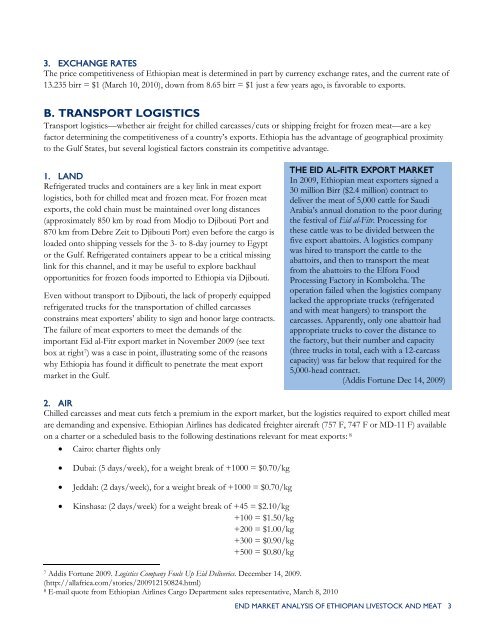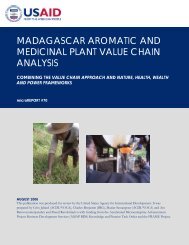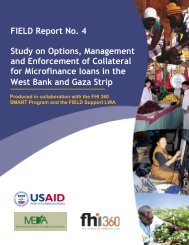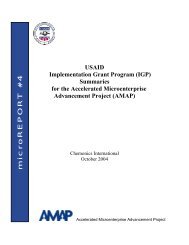End Market Analysis of Ethiopian Livestock and ... - USAID Microlinks
End Market Analysis of Ethiopian Livestock and ... - USAID Microlinks
End Market Analysis of Ethiopian Livestock and ... - USAID Microlinks
Create successful ePaper yourself
Turn your PDF publications into a flip-book with our unique Google optimized e-Paper software.
3. EXCHANGE RATES<br />
The price competitiveness <strong>of</strong> <strong>Ethiopian</strong> meat is determined in part by currency exchange rates, <strong>and</strong> the current rate <strong>of</strong><br />
13.235 birr = $1 (March 10, 2010), down from 8.65 birr = $1 just a few years ago, is favorable to exports.<br />
B. TRANSPORT LOGISTICS<br />
Transport logistics—whether air freight for chilled carcasses/cuts or shipping freight for frozen meat—are a key<br />
factor determining the competitiveness <strong>of</strong> a country’s exports. Ethiopia has the advantage <strong>of</strong> geographical proximity<br />
to the Gulf States, but several logistical factors constrain its competitive advantage.<br />
1. LAND<br />
Refrigerated trucks <strong>and</strong> containers are a key link in meat export<br />
logistics, both for chilled meat <strong>and</strong> frozen meat. For frozen meat<br />
exports, the cold chain must be maintained over long distances<br />
(approximately 850 km by road from Modjo to Djibouti Port <strong>and</strong><br />
870 km from Debre Zeit to Djibouti Port) even before the cargo is<br />
loaded onto shipping vessels for the 3- to 8-day journey to Egypt<br />
or the Gulf. Refrigerated containers appear to be a critical missing<br />
link for this channel, <strong>and</strong> it may be useful to explore backhaul<br />
opportunities for frozen foods imported to Ethiopia via Djibouti.<br />
Even without transport to Djibouti, the lack <strong>of</strong> properly equipped<br />
refrigerated trucks for the transportation <strong>of</strong> chilled carcasses<br />
constrains meat exporters’ ability to sign <strong>and</strong> honor large contracts.<br />
The failure <strong>of</strong> meat exporters to meet the dem<strong>and</strong>s <strong>of</strong> the<br />
important Eid al-Fitr export market in November 2009 (see text<br />
box at right7) was a case in point, illustrating some <strong>of</strong> the reasons<br />
why Ethiopia has found it difficult to penetrate the meat export<br />
market in the Gulf.<br />
2. AIR<br />
Chilled carcasses <strong>and</strong> meat cuts fetch a premium in the export market, but the logistics required to export chilled meat<br />
are dem<strong>and</strong>ing <strong>and</strong> expensive. <strong>Ethiopian</strong> Airlines has dedicated freighter aircraft (757 F, 747 F or MD-11 F) available<br />
on a charter or a scheduled basis to the following destinations relevant for meat exports: 8<br />
• Cairo: charter flights only<br />
• Dubai: (5 days/week), for a weight break <strong>of</strong> +1000 = $0.70/kg<br />
• Jeddah: (2 days/week), for a weight break <strong>of</strong> +1000 = $0.70/kg<br />
• Kinshasa: (2 days/week) for a weight break <strong>of</strong> +45 = $2.10/kg<br />
+100 = $1.50/kg<br />
+200 = $1.00/kg<br />
+300 = $0.90/kg<br />
+500 = $0.80/kg<br />
7 Addis Fortune 2009. Logistics Company Fouls Up Eid Deliveries. December 14, 2009.<br />
(http://allafrica.com/stories/200912150824.html)<br />
8 E-mail quote from <strong>Ethiopian</strong> Airlines Cargo Department sales representative, March 8, 2010<br />
THE EID AL-FITR EXPORT MARKET<br />
In 2009, <strong>Ethiopian</strong> meat exporters signed a<br />
30 million Birr ($2.4 million) contract to<br />
deliver the meat <strong>of</strong> 5,000 cattle for Saudi<br />
Arabia’s annual donation to the poor during<br />
the festival <strong>of</strong> Eid al-Fitr. Processing for<br />
these cattle was to be divided between the<br />
five export abattoirs. A logistics company<br />
was hired to transport the cattle to the<br />
abattoirs, <strong>and</strong> then to transport the meat<br />
from the abattoirs to the Elfora Food<br />
Processing Factory in Kombolcha. The<br />
operation failed when the logistics company<br />
lacked the appropriate trucks (refrigerated<br />
<strong>and</strong> with meat hangers) to transport the<br />
carcasses. Apparently, only one abattoir had<br />
appropriate trucks to cover the distance to<br />
the factory, but their number <strong>and</strong> capacity<br />
(three trucks in total, each with a 12-carcass<br />
capacity) was far below that required for the<br />
5,000-head contract.<br />
(Addis Fortune Dec 14, 2009)<br />
END MARKET ANALYSIS OF ETHIOPIAN LIVESTOCK AND MEAT 3





